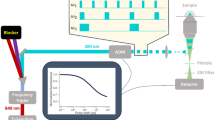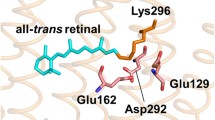Abstract
Ciliate Euplotes octocarinatus centrin (EoCen) is a member of the EF-hand superfamily of calcium-binding proteins. It has been proven, using Tb3+ as a fluorescence probe, that EoCen has four calcium-binding sites. The sensitized emission arises from nonradiative energy transfer between the three tyrosine residues (Tyr46, Tyr72, and Tyr79) of the N-terminal half and the bound Tb3+ ions. To determine the most critical of the three tyrosine residues for the process of fluorescence resonance energy transfer, six mutants of the N-terminal domain of EoCen, which contain one (N-Tyr46/N-Tyr72/N-Tyr79) or two (N-Y46F/N-Y72F/N-Y79F) tyrosine residues, were obtained by site-directed mutagenesis. The aromatic residue-sensitized Tb3+ fluorescence of N-Y79F was most affected, displaying a 50% reduction compared with wild-type N-EoCen. Among the tyrosines, Tyr79 is the shortest mean distance from the protein-bound Tb3+ (at sites I/II), as calculated via the Förster mechanism. The steady-state and time-resolved fluorescence parameters of the wild-type N-EoCen and the three double mutants suggest that Tyr79, which exists in a hydrophobic environment, has the highest quantum yield and a relatively long average lifetime. The decay of Tyr79 is the least heterogeneous among the three tyrosine residues. In addition, molecular modeling shows that a critical hydrogen bond is formed between the 4-hydroxyl group of Tyr79 and the oxygen from the side chains of the residue Asn39. Kinetic experiments on tyrosine and Tb3+ fluorescence demonstrate that tyrosine fluorescence quenching is largely due to the self-assembly of EoCen, and that the quenching degrees of the mutants differ. Resonance light scattering and crosslinking analysis carried out on the full-length single mutants (Y46F, Y72F, and Y79F) showed that Tyr79 also plays the most important role in the Tb3+-dependent self-assembly of EoCen among the three tyrosines.








Similar content being viewed by others
Abbreviations
- CaM:
-
Calmodulin
- EoCen:
-
Wild-type ciliate Euplotes octocarinatus centrin
- FRET:
-
Fluorescence resonance energy transfer
- HEPES:
-
4-(2-Hydroxyethyl)-1-piperazineethanesulfonic acid
- IPTG:
-
Isopropyl-d-thiogalactopyranoside
- LB:
-
Luria–Bertani
- Phe:
-
Phenylalanine
- PBS:
-
Phosphate-buffered saline
- RLS:
-
Resonance light scattering
- TNS:
-
2-pToluidinylnaphthalene-6-sulfonate
- N-EoCen:
-
N-Terminal domain (1–101) of wild-type EoCen
- Y46F/Y72F/Y79F:
-
The three single mutants of full-length EoCen in which one tyrosine (Y) residue has been replaced by phenylalanine (F)
- N-Y46F/N-Y72F/N-Y79F:
-
The three single mutants of N-EoCen in which one tyrosine (Y) residue has been replaced by phenylalanine (F), each of which contains two tyrosine residues
- N-Try46/N-Tyr72/N-Tyr79:
-
The three double mutants of N-EoCen, each of which contains a single tyrosine residue
- Tyr:
-
Tyrosine
- TEMED:
-
N,N,N′,N′-Tetramethylethylenediamine
References
Salisbury JL, Baron A, Surek B, Melkonian M (1984) J Cell Biol 99:962–970
Salisbury JL (1995) Curr Opin Cell Biol 7:39–45
Salisbury JL, Kelly MS, Busby R, Springett M (2002) Curr Biol 12:1287–1292
Schieble E, Bornens M (1995) Trends Cell Biol 5:197–201
Wolfrum U, Geisl A, Pulvermüller A (2002) Centrins, a novel group of Ca2+-binding proteins in vertrbrate photoreceptor cells. In: Baehr W, Palczewski K (eds) Photoreceptors and calcium. Kluwer, New York, pp 155–178
Tourbez M, Firanescu C, Yang A, Unipan L, Duchambon P, Blouquit Y, Craescu CT (2004) J Biol Chem 279:47672–47680
He XJ, Feng JY, Wang W, Chai BF, Yang BS, Liang AH (2004) Acta Zool Sin 50:47–451
Wang ZJ, Zhao YQ, Ren LX, Li GT, Liang AH, Yang BS (2007) J Photochem Photobiol A 186:178–186
Zhao YQ, Feng JY, Liang AH, Yang BS (2009) Spectrochim Acta A 71:1756–1761
Evans CH (1990) Biochemistry of lanthanides. Plenum, New York
Wang K, Li RC, Cheng Y, Zhu B (1999) Coord Chem Rev 190–192:297–308
Selvin PR (2000) Nat Struct Biol 7:730–734
Selvin PR (1996) IEEE J Select Topics Quantum Electron 2:1077–1087
Horrocks WD, Sudnick DR (1981) Acc Chem Res 14:384–392
Reuben J (1979) In: Gschneider KA, Eyring L (eds) Handbook on the physics and chemistry of rare earths, vol 3. North-Holland, Amsterdam, pp 515–552
Bertini I, Gupta YK, Luchinat C, Parigi G, Peana M, Sgheri L, Yuan J (2007) J Am Chem Soc 129:12786–12794
Bertini I, Kursula P, Luchinat C, Parigi G, Vahokoski J, Wilmanns M, Yuan J (2009) J Am Chem Soc 131:5134–5144
Kilhoffer MC, Demaille JG, Gĕrard D (1981) Biochemistry 20:4407–4414
Bruno J, Horrocks WD, Zauhar RJ (1992) Biochemistry 31:7016–7026
Wiech H, Geier BM, Paschke T, Spang A, Grein K, Steinkötter J, Melkonian M, Schiebel E (1996) J Biol Chem 271:22453–22461
Duan L, Zhao YQ, Wang ZJ, Li GT, Liang AH, Yang BS (2008) J Inorg Biochem 102:268–277
He ML, Rambeck WA (2000) Arch Tierernahr 53:323–334
Blouquit Y, Duchambon P, Brun E, Marco S, Rusconi F, Sicard-Roselli C (2007) Free Radic Biol Med 43:216–228
Ren LX, Zhao YQ, Feng JY, He XJ, Liang AH, Yang BS (2006) Chin J Inorg Chem 22:87–90
Mach H, Middaugh CR, Lewis RV (1992) Anal Biochem 200:74–80
Eisinger J (1969) Photochem Photobiol 9:247–258
Chen RF (1967) Anal Lett 1:35–42
Föster T (1948) Ann Phys (Leipzig) 2:55–75
Horrocks WD, Collier WE (1981) J Am Chem Soc 103:2856–2862
McClure WO, Edelman GM (1966) Biochemistry 5:1908–1919
Durussela I, Blouquitb Y, Middendorpc S, Craescub CT, Cox JA (2000) FEBS Lett 472:208–212
Salisbury JL (1998) J Eukaryot Microbiol 45:28–32
Mallamace F, Micali N, Romeo A, Scolaro LM (2000) Curr Opin Coll Interf Sci 5:49–55
Yang A, Miron S, Duchambon P, Assairi L, Blouquit Y, Craescu CT (2006) Biochemistry 45:880–889
Łukomska J, Rzeska A, Malicka J, Wiczk W (2001) J Photochem Photobiol A Chem 143:135–139
Ye YM, Lee HW, Yang W, Shealy S, Yang JJ (2005) J Am Chem Soc 127:3743–3750
Bogan AA, Thorn KS (1998) J Mol Biol 280:1–9
Daunderer C, Schliwa M, Gräf R (2001) Eur J Cell Biol 80:621–630
Levy YY, Lai EY, Remillard SP, Heintzelman MB, Fulton C (1996) Cell Motil Cytoskelet 33:298–323
Salisbury JL (2004) Curr Biol 14:R27–R29
Srsen V, Merdes A (2006) Cell Div 1:26–30
Acknowledgments
This work was supported by the National Natural Science Foundation of PR China (No. 20901048 and No. 20771068), and the Natural Science Foundation of Shanxi Province (No. 2007011024). The Ph.D Programs Foundation of Ministry of Education of China (20091401110007).
Author information
Authors and Affiliations
Corresponding author
Electronic supplementary material
Below is the link to the electronic supplementary material.
Rights and permissions
About this article
Cite this article
Duan, L., Liu, W., Wang, ZJ. et al. Critical role of tyrosine 79 in the fluorescence resonance energy transfer and terbium(III)-dependent self-assembly of ciliate Euplotes octocarinatus centrin. J Biol Inorg Chem 15, 995–1007 (2010). https://doi.org/10.1007/s00775-010-0660-z
Received:
Accepted:
Published:
Issue Date:
DOI: https://doi.org/10.1007/s00775-010-0660-z




